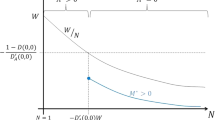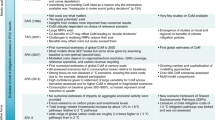Abstract
The future consequences of climate change are highly uncertain and estimates of economic damages differ widely. Governments try to cope with these risks by investing in mitigation and adaptation measures. In contrast to most of the existing literature, we explicitly model the decision of risk averse governments on mitigation and adaptation policies. We also consider the interaction of the two strategies in presence of uncertainty. Mitigation efforts of a single country trigger crowding out as other countries will reduce their mitigation efforts. This may even lead to lower mitigation on the global scale. In contrast, a unilateral commitment to large adaptation efforts benefits the single country and can reduce the global risk from climate change at the expense of other countries.



Similar content being viewed by others
Notes
In an experimental setting, Sturm and Weimann (2008) confirm Hoel’s result, when countries decide simultaneously on the public good contribution. Numerous other extensions have been developed, e.g. Vicary (2009) modifies the model of non-cooperative mitigation policy to analyze asymmetries between countries.
There is a broad literature on further strategic aspects in general models of the private provision of public goods. For instance, countries may prefer to remain uninformed about their country-specific benefits from a public good (Morath 2010). This underinvestment helps them to credibly commit to a low level of public good contribution and to free ride on the other countries. Related to this, players may strategically abstain from purchasing insurance, even if it is offered for a fair premium, if they take part in a game of private provision of a public good later (Robledo 1999). For other forms of strategic behavior, see Konrad (1994), Ihori (1996), Buchholz et al. (1998) and Siqueira (2003).
For an experimental setting, see Hasson et al. (2010) who introduce uncertainty about climate change to test whether participants contribute more in high-vulnerability treatments.
This simplifies the analysis considerably and allows us to study the strategic context. Evidently it disregards the fact that some countries in the rest of the world may be in a corner solution.
As all distributions in the choice set belong to the same linear class, the mean-variance-approach is equivalent to the expected utility approach; see Meyer (1987) and Sinn (1989). The latter also contains a comprehensive treatment of the mean-variance-approach. Lohse et al. (2012) use the expected utility framework, which allows them to distinguish between self-insurance and self-protection. This distinction is most suitable with two states of the world (damage/no damage). As mitigation affects the entire distribution of damages, this distinction is of little practical relevance here. The mean-variance-approach has the advantage of dealing elegantly with continuous damage distributions.
National pledges as formulated in the Copenhagen Accord or the nationally determined contributions (NDC), which are part of the Paris Agreement, can also be interpreted as unilateral advances in mitigation. Crowding-out effects as reaction to national pledges have been studied, e.g., by Bosetti and Cian (2013).
In contrast to Hoel (1991), we do not explicitly model the benefit that is experienced by country 2 from the increase in mitigation efforts. We simply consider an exogenous deviation from the utility maximizing mitigation effort and focus on the impact on total mitigation. Hence, we abstract from the question why a country may want to depart from the Nash equilibrium (e.g., for political motives, warm-glow motives ...).
Note that the minor differences emerge due to the different settings. We have convex costs, whereas Lohse et al. (2012) employ a linear specification. In the mean-variance-approach, mitigation simultaneously shifts and squeezes the damage distribution whereas Lohse et al. (2012) distinguish two types of mitigation technologies (self-insurance and self-protection).
The second-order conditions are documented in Appendix 5.3.
To be precise, the sign depends on the absolute risk aversion and on the convexity of the cost function; see Sect. 2. We neglect the special cases, where extreme values of increasing absolute risk aversion and/or convex costs could make the reaction curve upward-sloping.
In Appendix 5.4, we derive the formal condition for partial crowding out and over-crowding out in the extended model with adaptation and mitigation.
References
Aldy JE (2010) Designing climate mitigation policy. J Econ Lit 48(4):903–934
Bergstrom T, Blume L, Varian H (1986) On the private provision of public goods. J Public Econ 29(1):25–49
Bosello F, Chen C (2010) Adapting and mitigating to climate change: balancing the choice under uncertainty, Fondazione Eni Enrico Mattei—Sustainable developement series 159—Technical report
Bosetti V, Cian ED (2013) A good opening: the key to make the most of unilateral climate action. Environ Resource Econ 56:255–276
Bramoullé Y, Treich N (2009) Can uncertainty alleviate the commons problem? J Eur Econ Assoc 7(5):1042–1067
Buchholz W, Nett L, Peters W (1998) The strategic advantage of being less skilled. Econ Lett 60(1):35–39
Ebert U, Welsch H (2012) Adaptation and mitigation in global pollution problems: economic impacts of productivity, sensitivity, and adaptive capacity. Environ Resource Econ 52:49–64
Fankhauser S, Smith JB, Tol RSJ (1999) Weathering climate change: some simple rules to guide adaptation decisions. Ecol Econ 30(1):67–78
Farnham M, Kennedy P (2015) Adapting to climate change: equilibrium welfare implications for large and small economies. Environ Resource Econ 61:345–363
Hasson R, Löfgren A, Visser M (2010) Climate change in a public goods game: investment decision in mitigation versus adaptation. Ecol Econ 70(2):331–338
Heuson C (2015) Investment and adaptation as commitment devices in climate politics. Environ Resource Econ 62(4):769–790
Hoel M (1991) Global environmental problems: the effects of unilateral actions taken by one country. J Environ Econ Manag 20(1):55–70
Ihori T (1996) International public goods and contribution productivity differentials. J Public Econ 61(1):139–154
Ingham A, Ma J, Ulph AM (2007) Climate change, mitigation and adaptation with uncertainty and learning. Energy Policy 35(11):5354–5369
Ingham A, Ma J, Ulph AM (2013) Can adaptation and mitigation be complements? Clim Change 120(1–2):39–53
Intergovernmental Panel on Climate Change (2013) Climate change 2013—the physical science basis: contribution of working group I to the fifth assessment report of the IPCC. Cambridge University Press, Cambridge
Kane S, Shogren JF (2000) Linking adaptation and mitigation in climate change policy. Clim Change 45(1):75–102
Konrad KA (1994) The strategic advantage of being poor: private and public provision of public goods. Economica 61(241):79–92
Lohse T, Robledo JR, Schmidt U (2012) Self-insurance and self-protection as public goods. J Risk Insur 79(1):57–76
Meyer J (1987) Two-moment decision models and expected utility maximization. Am Econ Rev 77(3):421–430
Morath F (2010) Strategic information acquisition and the mitigation of global warming. J Environ Econ Manag 59(2):206–217
Robledo JR (1999) Strategic risk taking when there is a public good to be provided privately. J Public Econ 71(3):403–414
Sinn H-W (1989) Economic decisions under uncertainty, 2nd edn. Physica-Verlag, Heidelberg
Siqueira K (2003) International externalities, strategic interaction, and domestic politics. J Environ Econ Manag 45(3):674–691
Sturm B, Weimann J (2008) Unilateral emission abatement: an experiment. In: Cherry T, Shogren J, Kroll S (eds) Environmental economics, experimental methods. Routledge, London, pp 157–183
Tol RSJ (2009) The economic effects of climate change. J Econ Perspect 23(2):29–51
Tol RSJ (2013) Targets for global climate policy: an overview. J Ecn Dyn Control 37(5):911–928
Tol RSJ (2014) Correction and update: the economic effects of climate change. J Econ Perspect 28(2):221–226
Tol RSJ, Yohe GW (2007) Infinite uncertainty, forgotten feedbacks, and cost-benefit analysis of climate policy. Clim Change 83(4):429–442
Tsur Y, Withagen C (2013) Preparing for catastrophic climate change. J Econ 110:225–239
Vicary S (2009) The voluntary provision of a public good in an international commons. Can J Econ 42(3):984–996
Zehaie F (2009) The timing and strategic role of self-protection. Environ Resour Econ 44(3):337–350
Acknowledgements
We thank Kjell Erik Lommerud, Alf Erling Risa, Sigve Tjøtta, Gaute Torsvik and Kjell Vaage an two anonymous reviewers for very helpful comments and suggestions. This research is funded by the German Federal Ministry of Education and Research (BMBF) within the funding priority ’Economics of Climate Change’ (Grant no. 01LA1106A).
Author information
Authors and Affiliations
Corresponding author
Appendix
Appendix
1.1 Reaction curve
The derivatives of Eq. (3) amount to
and
Note that Eqs. (A.21) and (A.22) have similar structures. Hence, we can write
Substituting in (6) leads to Eq. (7).
1.2 Absolute risk aversion
Let S be the slope of the indifference curve: [\(S\equiv \frac{d \mu _i}{d\sigma _i}|_{\bar{U}}=-\frac{U_{\sigma }}{U_{\mu }}\) with \(U_\mu >0\), \(U_\sigma <0\) and \(i=1,2\)]. Absolute risk aversion is decreasing (increasing) if the slope of the indifference curve decreases (increases) with \(\mu _i\) (see, for instance, Sinn 1989). Taking the derivative of S with respect to \(\mu _i\) yields
Hence, absolute risk aversion is
1.3 Second-order condition
The second-order conditions are
We can rewrite the second-order condition \(|D|>0\) as
with
and \(i,j=\{a,m\}\). The second-order condition is always fulfilled if we have
-
(A1)
\(A<0\)
-
(A2)
\(\alpha _{ii}-\alpha _{ij}>0\),
i.e. the cross-derivative \(U_{\mu \sigma }\) should not be too strongly positive and an increase in climate measure i reduces the marginal productivity \(\alpha _{i}\) more than an increase in measure j. The latter implies some degree of complementarity between adaptation and mitigation. In the case with perfect substitutability, we have \(\alpha _{ij}=0\).
1.4 Crowding out
The change of mitigation of country i as reaction on an increase of mitigation by country j is given by:
Taking the derivative of (12) with respect to \(m_{i}\) yields.
The corresponding derivative with respect to \(m_{j}\) is
As Eqs. (A.29) and (A.30) have similar structures, we can also write
Finally, using \(f_{a_i m_i}=f_{a_i m_j}=f_{m_i a_i}\), Eq. (A.28) can be rewritten as
A comparison with Eq. (7) immediately shows that the condition for over-crowding out is the same in the extended model as in our baseline model of Sect. 2.
Rights and permissions
About this article
Cite this article
Auerswald, H., Konrad, K.A. & Thum, M. Adaptation, mitigation and risk-taking in climate policy. J Econ 124, 269–287 (2018). https://doi.org/10.1007/s00712-017-0579-8
Received:
Accepted:
Published:
Issue Date:
DOI: https://doi.org/10.1007/s00712-017-0579-8




